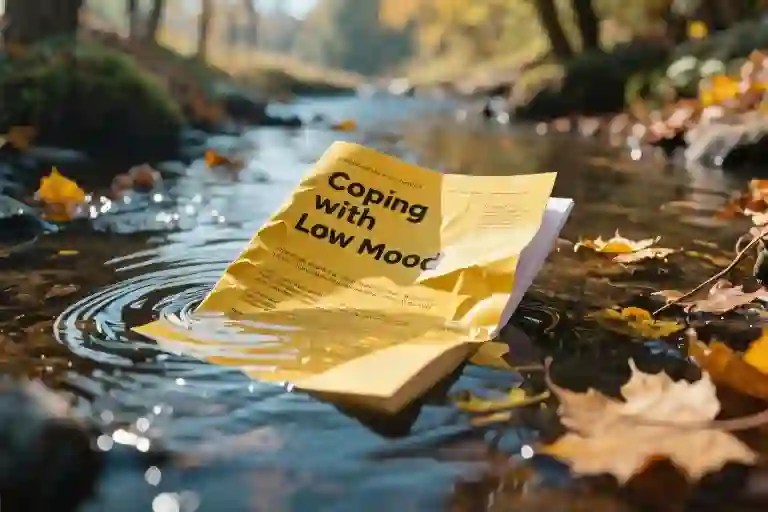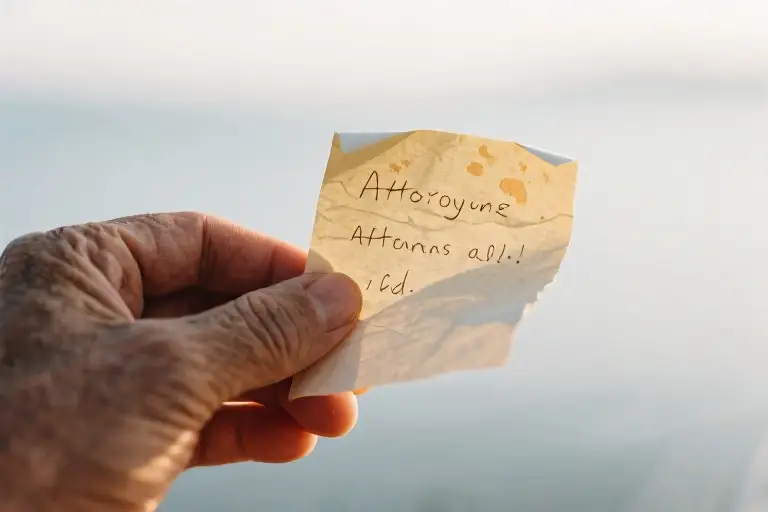The office smelled like artificial lemon and something faintly metallic. I sat in the mismatched chair—the one with the wobbly leg—watching dust particles float in the strip of sunlight between the blinds. My therapist’s pen hovered over her notepad, waiting. I’d rehearsed this moment all week.
‘Food tastes like cardboard,’ I said, pressing my thumb into the chair’s armrest. ‘I push it around my lunch tray until the bell rings.’ The cheap carpet fibers itched my ankles where my socks didn’t quite meet my jeans. She nodded without looking up, her pen scratching across the paper.
When I mentioned the insomnia—how 3am became my most familiar hour—she finally met my eyes. For a second, I thought she understood. Then she reached for the plastic-wrapped pamphlet on her desk. ‘Coping with Low Mood’ glared up at me in cheerful yellow letters, a stick-figure teen hiking up a mountain on the cover.
‘Grief isn’t depression,’ I wanted to say as she explained the benefits of regular exercise. But my throat closed around the words. The train whistle still echoed in my dreams, that terrible metallic shriek cutting through our last text thread—Dude grab your skateboard, the tracks by Miller’s field—
The tissue box between us sat untouched, its pastel flowers absurdly bright. Real sorrow, I was learning, doesn’t come with convenient leaking eyes. It settles in your bones, replaces your saliva with glue, turns every meal into a chore. None of which fit neatly in the pamphlet’s checklist.
Outside, a car door slammed. Some other kid arriving for their fifty minutes of measured breathing and symptom charts. I folded a corner of the pamphlet, creasing the smiling stick figure in half. Three weeks since the funeral, and the world kept insisting I should be getting better. But grief doesn’t follow recovery timelines, and train tracks don’t care about closure.
When Pain Meets the Template
The office smelled like artificial lavender and stale coffee. I sat in the mismatched chair – the one with the wobbly leg that made small scraping sounds whenever I shifted my weight. My therapist’s pen hovered over her notepad, waiting. Outside, a lawnmower droned in the distance.
“I’m not sleeping,” I said. The words came out flat, like I was reading from a grocery list. “I watch the ceiling until 3 AM most nights. Then I get up and go to school like everything’s normal.”
Her pen moved across the paper. A checkmark? A note? I couldn’t tell. The carpet had a stain near my left foot, shaped vaguely like Australia.
“Food tastes like nothing now,” I continued. “At lunch I push the cafeteria food around until the bell rings. It’s been weeks since I ate a full meal.”
I took a sip from the paper cup she’d given me. The water tasted metallic. The tissues on the table between us sat untouched in their cardboard box, still perfectly arranged in that zigzag pattern they come in.
When I told her about the train – about Michael – she paused just long enough to make me think she might say something real. Then came the pamphlet. Coping with Low Mood in Adolescents. The cover showed cartoon teenagers playing basketball and laughing.
“The feelings will pass,” she said. “Staying active helps.”
I stared at the pamphlet’s creased corner where she’d gripped it too tightly. The office air conditioner kicked on with a rattle. Somewhere in the building, a phone rang and rang.
What I wanted to say: This isn’t about mood. My best friend’s body was torn apart by steel and speed. I can still hear his sister screaming when they told her. The world should stop, but the clocks keep ticking and the lawnmowers keep mowing and you keep handing out these fucking pamphlets.
What I actually said: “Okay. Thanks.”
The chair scraped the floor again as I stood up. She asked if I wanted to schedule another appointment. I said I’d think about it. The door clicked shut behind me with a sound like the latch on a jewelry box – small, final, meaningless.
When Grief Gets Mislabeled
The pamphlet’s title glared up at me in cheerful font: Coping with Low Mood. I ran my finger along its creased edge, the paper fibers catching on my dry skin. Nothing in those pages mentioned the hollowed-out feeling that came with watching your best friend’s locker stay empty week after week. Nothing prepared me for how orange juice could suddenly taste like tap water, or why 3 AM became my most familiar hour.
Medical charts would call this insomnia and loss of appetite – textbook depression symptoms. But depression doesn’t explain why I could still laugh at YouTube videos, or why the sadness came in waves rather than a constant fog. My biology teacher’s explanation of fight-or-flight responses made more sense: my body was stuck treating grief like a physical threat, rationing sleep and taste as if preparing for battle.
Research shows nearly 80% of bereaved teens get funneled into standard depression protocols. The system sees sadness and reaches for its usual tools: mood charts, serotonin reuptake inhibitors, advice about exercise and sunlight. What often gets missed are the unique markers of complex grief:
- Time distortion: Not just trouble sleeping, but your internal clock rewiring itself around absence (that 3 AM wakefulness? Often matches trauma timing)
- Sensory shifts: Food tasting bland isn’t about appetite – it’s the brain diverting resources from “non-essential” functions
- Memory glitches: Perfect recall of your last conversation, but forgetting what day it is
- Bodily echoes: Developing your friend’s quirks (their nervous cough, their handwriting slant)
The clinic’s depression screening questionnaire asked if I “felt hopeless about the future.” But my problem wasn’t hopelessness – it was furious, desperate certainty that the future could never contain what I’d lost. No checkbox existed for “I keep typing his name into group chats by accident” or “I smell his shampoo on strangers.”
Grief specialist Dr. Tasneem Khataw describes this as presence of absence – not an emotional state, but a recalibration of your entire sensory world. The brain struggles to process how someone can simultaneously be gone (no new memories being made) yet everywhere (their favorite song playing at the grocery store). Standard therapy often misinterprets this as denial or dissociation.
What helped more than any counseling session was finding the 2019 Boston Children’s Hospital study on adolescent grief responses. Their brain scans showed something revolutionary: grieving teens don’t have underactive emotional centers (like in depression), but overactive memory networks. My midnight wakefulness wasn’t malfunction – it was my hippocampus working overtime to preserve every detail about him before time eroded them further.
The pamphlet suggested keeping a regular sleep schedule. What I needed was someone to say: “Of course you’re awake. Your mind is building a museum.”
The Words That Could Have Helped
The chair creaked as I shifted my weight, waiting for something more than a pamphlet about mood swings. What came instead was the kind of silence that makes you question whether you’ve spoken aloud at all. My therapist’s pen hovered over her notepad, leaving behind small ink stains that looked like bruises on the paper.
Later, a grief specialist would explain how those missed opportunities for connection compound trauma. “Effective grief counseling starts with four verbal pillars,” she told me, reconstructing that disastrous session sentence by sentence. Where my original therapist had said “Everyone feels down sometimes,” an attuned response might have been: “Tell me about the last conversation you had with him.” The difference lives in the specificity – naming the loss rather than generalizing the pain.
Language patterns matter profoundly in bereavement support. Validating statements (“This must feel unbearable”) land differently than reassurances (“You’ll feel better soon”). Open-ended questions (“What does the grief feel like in your body?”) create more space than diagnostic checklists (“Are you having trouble sleeping?”). The most skilled therapists use what we call “landing phrases” – brief acknowledgments that the words just heard have been received (“I’m holding this with you”).
What surprised me most was learning how professionals track “absence language” – the things we don’t say that amplify isolation. When no one mentions my friend’s name, when teachers avoid looking at me in the hallway, these linguistic voids make the loss somehow more invisible. Good grief counseling names the elephant in the room rather than rearranging furniture around it.
There’s an art to companioning versus fixing. My reconstructed dialogue showed the therapist reflecting rather than advising (“I hear how meaningless food tastes now”), exploring rather than pathologizing (“Does the insomnia feel different from regular tiredness?”). She would have noticed how I clenched the water bottle when describing the train – a somatic clue worth gently naming.
Of course, no perfect words erase loss. But certain phrases become handrails in freefall: “Nothing about this is okay, and I’m here anyway.” “His absence is a physical weight today.” “Tell me one thing you wish he could know.” These utterances don’t heal, but they witness – which is often what grieving teens need most.
Some therapists worry about saying the wrong thing. The greater risk is saying nothing particular at all. That generic pamphlet now lives in my drawer as a reminder: real healing begins when someone dares to speak directly to your unique storm.
When There Are No Guides
The pamphlets never tell you what to do when your world cracks open. They don’t mention how to breathe when the air feels thick with absence, or why your hands shake when tying shoelaces becomes a monumental task. Grief doesn’t follow their tidy timelines, and healing certainly doesn’t fit into their bullet-pointed lists.
First weeks: Survival mode
Your body will rebel in ways no health class prepared you for. Food might taste like cardboard, sleep could become this elusive creature you chase until dawn. This isn’t failure – it’s your nervous system responding to seismic loss. Try keeping crackers by your bed, the plain salted kind. When eating feels impossible, let them dissolve on your tongue like communion wafers. Hydration matters more than meals right now; mark water bottles with hourly goals if you need to.
Months two through four: The phantom limb phase
You’ll turn to share a joke with someone who isn’t there. Their ringtone will play in crowded places. These aren’t signs you’re losing it – they’re proof of how deeply someone mattered. Create a digital memorial: a playlist of songs they loved, a cloud folder for photos friends share. When the weight threatens to crush you, press play on track three (the one they always sang off-key) and let the awful beauty of that imperfection remind you what love sounds like.
Beyond the calendar’s reach: Carrying and being carried
Anniversaries will ambush you – not just death dates, but the first day of school without their sarcastic commentary, the movie premiere they’ll never see. Plant something perennial where you can talk to them. Not a headstone, but a raspberry bush that yields fruit each summer, or a magnolia tree that drops pink petals like whispered replies. When people ask why you’re gardening, tell them you’re learning how things grow even when you can’t watch them every second.
The playlist project
Start with five songs:
- The one you both secretly loved but pretended to hate
- The track playing when you met
- Their shower-singing anthem
- Something with lyrics they misheard hilariously
- A new release you wish you could dissect together
Add one song monthly. Over years, it becomes a time capsule of continuing bonds.
What no one prepares you for
Grief isn’t a linear progression. Some days you’ll function like a normal human, then suddenly smell their shampoo in a crowded elevator. These aren’t setbacks – they’re visitations. Keep a notebook for these moments, not to analyze them, but to honor their fleeting presence. Write in fragments if that’s all you can manage:
“3:17 PM – Sunlight hit the gym bleachers the exact way it did during sophomore pep rally. For half a breath, I heard your laugh.”
There are wildernesses no map can chart. But footprints appear when you least expect them – in a stranger’s unexpected kindness, in lyrics that arrive like answered questions, in the stubborn resilience of your own pulse keeping time when the world has stopped.
Finding Your Way Through the Fog
The pamphlet from my therapist still sits on my nightstand, its corners curled from being picked up and put down so many times. Coping with Low Mood: Strategies for Young People. The title alone made me want to scream. Low mood? Is that what they call lying awake until 3 AM imagining the sound of train brakes? Is that the clinical term for pushing food around a lunch tray because everything tastes like cardboard since your best friend stopped existing?
When professional help fails you, the wilderness of grief becomes even more disorienting. But here’s what I wish someone had told me: there are better maps available. You just have to know where to look.
The Red Flags of Generic Counseling
Most therapists aren’t trained in grief specifically. They’ll try to fit your experience into categories they know – depression, anxiety, adjustment disorder. Look out for these warning signs:
- They use the same worksheets for grief as they do for test anxiety
- Your sessions feel like checking off symptoms from a list
- Phrases like time heals all wounds or stay positive come up repeatedly
- They seem uncomfortable when you describe the physical aspects (the nausea, the muscle aches, the way your hands shake)
A good grief counselor won’t make you feel like a problem to be solved. They’ll sit with you in the messy, nonlinear reality of loss.
What Specialized Grief Support Looks Like
After months of dead-end sessions, I found a counselor who actually understood. The differences were immediate:
- They asked about him by name – Not your friend, but What would Alex think about that?
- Space for anger – Where my old therapist suggested breathing exercises, this one handed me a stack of plates to smash (safely, in their backyard)
- Body awareness – We didn’t just talk feelings; we tracked how grief lived in my shoulders, my stomach, my clenched jaw
- Creative options – Sometimes words failed, so we used music, clay, even TikTok duets with his old videos
Three Places That Get It Right
Through trial and painful error, I discovered organizations doing grief work differently:
The Dougy Center (Portland, OR / Virtual)
- Peer support groups divided by loss type (sudden death vs illness vs suicide)
- No age mixing – teens meet separately from younger kids
- Why it works: Being with others who actually understand eliminates the exhausting task of explaining your pain
Ele’s Place (Michigan Branches)
- Art and music therapy built into every session
- Family nights where siblings/parents process grief together then separately
- Standout feature: Memory-making workshops (recording songs, painting memorial stones)
Experience Camps (National Locations)
- Free weeklong camps for grieving kids
- Trauma-informed staff trained in active remembering techniques
- Unexpected benefit: Physical activities (like rock climbing) rebuild the body’s sense of safety
Building Your Own Support System
When specialized help isn’t accessible, these strategies helped me cobble together something that worked:
- The 10% rule: For every person who says Let me know if you need anything, assign them a specific task (Can you text me every Tuesday with a memory of him?)
- Grief playlists: Mine had three sections – songs for crying, songs for rage, songs that reminded me to eat
- Secondary losses journal: Beyond missing him, I gunned for the basketball team we tried out for together, our inside jokes now unheard
That pamphlet still collects dust on my nightstand. But next to it now sits a rock from Ele’s Place with his initials, a playlist QR code from my camp counselor, and the business card of a therapist who knows the difference between depression and grief. The path isn’t straight, but the markers help.
When Words Aren’t Enough
The pamphlet stayed on my nightstand for three days before I touched it again. Its cheerful blue font screamed “Get Active!” at me every morning, the exclamation point like a knife twisting in my ribs. On the fourth day, I took it to the creek behind our house, the one where Jamie and I used to skip stones until our arms ached.
Folding the glossy pages into a boat felt like the first honest thing I’d done in weeks. The current caught it immediately, carrying that useless advice downstream where it couldn’t hurt anyone else. Watching it bob between the rocks, I realized grief doesn’t fit in bullet points or five-step plans. Some losses change the shape of your world, and no amount of “staying busy” will mold it back.
What surprised me wasn’t the counselor’s failure to understand – adults disappoint you routinely by eighteen. It was discovering how many people mistake silence for healing. Teachers praised my “maturity” when I stopped crying in class. My basketball coach said I was “tough” for playing through the season. They all seemed relieved when I pretended to be okay, like my pain was an inconvenient weather system that had finally passed.
Here’s what nobody tells you about losing someone: the second month is harder than the first. That’s when the casseroles stop arriving, when people stop saying their sorries in that careful voice. The world moves on, dragging you along while parts of you stay buried with the person who’s gone. You become a walking contradiction – desperately wanting to talk about them, terrified of being that sad person everyone avoids.
I started testing phrases like a scientist running experiments:
- “I miss Jamie” made adults shift uncomfortably
- “My friend died last semester” got me excused from tests
- “I’m fine” unlocked the fastest escape routes
Grief in teens is particularly lonely because it arrives before we’ve learned the vocabulary for it. Children get to cry openly. Adults are allowed their mourning rituals. But teenagers? We’re expected to metabolize loss between algebra homework and college applications, as if sadness respects academic calendars.
The creek water had nearly dissolved my paper boat when something unexpected happened. A kid from my chemistry class – someone I’d never really talked to – sat down beside me on the bank. He didn’t offer platitudes or ask invasive questions. Just pointed at the disappearing pamphlet and said, “Mine was yellow.” Then he tossed in a folded dinosaur he’d made from his own useless counseling handout. We watched them sink together in silence that actually helped.
Maybe healing begins when we stop waiting for the right words and start recognizing the people brave enough to sit with us in the wrong ones. That chemistry kid became the first person I could talk to about Jamie without performing recovery. He understood that some days grief tastes like ashes, and other days it’s just there, like a shadow you’ve learned to walk with.
So I’ll ask you what I wish someone had asked me: How do you want your person remembered? Not how others think they should be, but in the messy, particular way that honors what they really were. For me, it’s telling stories about Jamie’s terrible guitar playing, the way he’d laugh at his own jokes before reaching the punchline. It’s admitting that some mornings, the missing still takes my breath away. And that’s okay.
Your turn.





